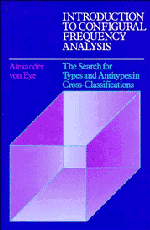 Introduction to Configural Frequency Analysis
Introduction to Configural Frequency Analysis Book contents
- Frontmatter
- Contents
- Preface
- Part I Concepts of configural frequency analysis
- Part II Applications and strategies of CFA
- 4 Global models of CFA: applications and examples
- 5 Regional models of CFA: applications and examples
- Part III Methods of longitudinal CFA
- Part IV Strategies of CFA and computational issues
- Appendix A Computational issues. The estimation of tail probabilities for the standard normal and the F distributions
- Appendix B Estimation of expected frequencies in 2 × 2 × 2 tables under the assumption that main effects and first order interactions exist
- Appendix C Critical alpha levels under Holm adjustment for up to 330 cells and a priori alphas 0.05 and 0.01
- References
- Subject index
- Author index
5 - Regional models of CFA: applications and examples
from Part II - Applications and strategies of CFA
Published online by Cambridge University Press: 04 August 2010
- Frontmatter
- Contents
- Preface
- Part I Concepts of configural frequency analysis
- Part II Applications and strategies of CFA
- 4 Global models of CFA: applications and examples
- 5 Regional models of CFA: applications and examples
- Part III Methods of longitudinal CFA
- Part IV Strategies of CFA and computational issues
- Appendix A Computational issues. The estimation of tail probabilities for the standard normal and the F distributions
- Appendix B Estimation of expected frequencies in 2 × 2 × 2 tables under the assumption that main effects and first order interactions exist
- Appendix C Critical alpha levels under Holm adjustment for up to 330 cells and a priori alphas 0.05 and 0.01
- References
- Subject index
- Author index
Summary
The last chapter discussed global CFA models. These models assign every variable the same status. For instance, first order CFA considers the main effects of all variables, and second order CFA considers all pairwise associations rather than a subset of them. Regional CFA models define groups of variables. Variables belonging to the same group may interact. Variables belonging to different groups are assumed to be independent from each other. If these assumptions are violated, types and antitypes indicate local relationships between the groups. The present chapter introduces the following regional models of CFA: interaction structure analysis (ISA; Krauth and Lienert 1974), d-sample CFA (Lienert 1971c), prediction CFA (PCFA; Lienert and Krauth 1973a), conditional CFA (Lienert 1978; Krauth 1980a), and CFA of directed relations (DCFA; von Eye 1985).
Interaction structure analysis
Most approaches to the analysis of relationships among several categorical variables define one interaction term for each group of three or more variables. For instance, information theory defines an interaction as “a unique dependency from which all relations of a lower ordinality are removed.” (Krippendorff 1986, p. 37; cf. von Eye 1985). However, in many instances, special concepts are necessary to meet with substantive assumptions. An example of such a concept is Krauth and Lienert's (1973a) definition of higher order interactions.
Higher order interactions can be defined only if there are at least three variables. For two variables, interactions coincide with simple associations that can be measured with, for example, chi-square coefficients. Krauth and Lienert consider a higher order interaction as the relationship between any two nonempty, nonoverlapping sets of variables.
- Type
- Chapter
- Information
- Introduction to Configural Frequency AnalysisThe Search for Types and Antitypes in Cross-Classification, pp. 82 - 142Publisher: Cambridge University PressPrint publication year: 1990
